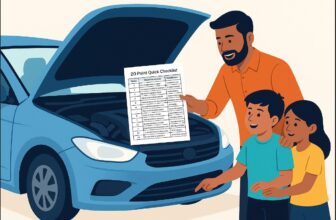Owning a car in India involves more than just understanding engines and gears. You also deal with documents, insurance policies, RTO procedures, and day-to-day maintenance. These are not technical engineering terms, but they’re equally important if you want to stay compliant with the law, protect your finances, and manage your vehicle responsibly.
If you’ve ever felt lost hearing words like IDV, hypothecation, or NCB from an insurance agent, you’re not alone. Even seasoned owners often misunderstand challans, warranty clauses, or the difference between OEM and aftermarket parts. Yet, these are the very details that affect how much you pay in fines, how your insurance claim is settled, or how easy it is to sell your car later.
This list explains 35 non-technical car terms that every owner deals with at some point, from registration and challans to insurance add-ons and maintenance contracts. By the end, you’ll have a clear understanding of the words that matter most in everyday car ownership.
Legal and Ownership Documents: Your Car’s Identity
1. Registration Certificate (RC)
The RC is the primary proof of vehicle ownership. It records details like chassis number, engine number, and owner name. Without it, you cannot legally drive on Indian roads.
In most states, the RC is now issued as a smart card or available digitally through DigiLocker, making it easier to carry.
2. Smart Card RC
Many RTOs have replaced paper RC books with compact plastic smart cards. They carry a chip or barcode with all vehicle details.
This modern format helps reduce forgery and is widely accepted across India.
3. Pollution Under Control (PUC) Certificate
A PUC certificate confirms that your car meets emission norms. It must be renewed every 6 to 12 months, depending on the vehicle.
Failing to produce a valid PUC can attract fines, especially in Delhi and other pollution-sensitive regions.
4. FASTag
An RFID-based tag fixed to your windscreen for automatic toll payments. Linked to your bank or wallet, it is mandatory at all national highway toll plazas.
FASTag saves time at tolls and also tracks your travel expenses digitally.
5. Road Tax
A one-time or lifetime tax levied by the state RTO at registration. The rate depends on the car’s value, fuel type, and state policies.
For instance, road tax is higher in Karnataka compared to some northern states.
6. Fitness Certificate
Mandatory for commercial vehicles like taxis and trucks, this document certifies roadworthiness.
Private cars don’t require it until 15 years old, when re-certification becomes necessary in many states.
7. Hypothecation
If your car is purchased on loan, the RC mentions the financier’s name. This is called hypothecation.
Once you clear the loan, you must apply to remove hypothecation at the RTO with a bank NOC.
8. Challan / E-Challan
A challan is a fine issued for traffic violations. With digitization, e-challans are now directly linked to your vehicle number plate.
You can check and pay these fines online through state transport portals.
9. No Objection Certificate (NOC)
When moving your car to another state, you must get an NOC from the current RTO. It certifies there are no dues or cases against the vehicle.
Skipping this step can block registration in the new state.
10. RTO Forms 28/29/30
These are forms required for ownership transfer, loan clearance, or interstate moves. Form 28 is for NOC, Form 29 for transfer notice, and Form 30 for transfer confirmation.
Dealers and agents often handle this paperwork, but knowing these forms helps avoid fraud.
Insurance and Finance Terms: Protecting Your Car and Wallet
11. Third-Party Insurance
The minimum legal insurance cover in India. It pays for damage caused to others but not for your own car.
This is cheaper but leaves your own vehicle unprotected.
12. Comprehensive Insurance
Covers both third-party liability and damage to your own car. It also covers theft, fire, and natural disasters.
This is the most common choice for private car owners in India.
13. Zero Depreciation Cover
An add-on policy where the insurer covers the full cost of parts replaced, without deducting depreciation.
Especially useful for new cars, as it saves thousands during claims.
14. No Claim Bonus (NCB)
A discount on your insurance premium for each claim-free year. It increases progressively up to 50%.
You can even transfer NCB when buying a new car.
15. Insured Declared Value (IDV)
The maximum amount your insurer will pay if your car is stolen or totaled. It reflects current market value, not purchase price.
IDV decreases each year as your car depreciates.
16. Deductibles
The fixed amount you pay from your pocket during an insurance claim.
Policies may have voluntary and compulsory deductibles. Choosing a higher voluntary deductible lowers premiums but raises risk.
17. Cashless Garage
Partner workshops where the insurer directly settles repair bills with the service center.
Cashless garages are widespread in metro cities but limited in smaller towns.
18. Engine Protection Cover
An add-on insurance that protects the engine from damage due to flooding or water ingress.
This is valuable in flood-prone cities like Mumbai and Chennai.
19. Return to Invoice (RTI) Cover
An add-on where the insurer reimburses the original invoice value of your car in case of total loss or theft.
RTI is especially useful for new cars in the first few years.
20. Personal Accident Cover
Mandatory cover provided with motor insurance for the driver. It offers compensation in case of accidental death or disability.
Some policies also extend this to passengers at extra cost.
Service and Maintenance: Keeping Your Car Roadworthy
21. Warranty
A manufacturer’s guarantee against defects for a fixed period, typically 2-5 years.
Warranties cover major components but exclude consumables like tyres or brake pads.
22. Extended Warranty
An optional paid plan extending coverage beyond the standard warranty.
Popular for long-term owners who want to avoid costly repairs later.
23. Service Interval
The recommended time or distance after which servicing is required, such as every 10,000 km or 12 months.
Skipping intervals can void warranty and reduce resale value.
24. AMC (Annual Maintenance Contract)
A prepaid maintenance package covering regular services.
It helps manage costs, especially for luxury brands with high service charges.
25. OEM Parts
Original Equipment Manufacturer parts supplied by the car brand.
They guarantee quality but cost more than aftermarket alternatives.
26. Aftermarket Parts
Third-party components used in place of OEM parts.
They’re cheaper but may not always match quality or fit.
27. Service Booklet
A logbook recording all maintenance history.
Dealers often check this before approving warranty claims.
28. Periodic Maintenance Service (PMS)
Standardized scheduled service including oil change, filter replacement, and inspection.
Most Indian brands promote PMS packages for consistency.
29. Consumables
Items like engine oil, brake fluid, coolant, and wiper fluid that need periodic replacement.
Though inexpensive individually, they form a recurring maintenance cost.
30. Alignment and Balancing
A service that ensures tyres wear evenly and the car drives straight.
Essential on Indian roads due to frequent pothole impacts.
Fuel and Everyday Use: Running Your Car Daily
31. Octane Rating
Indicates fuel quality. Petrol in India is usually 91 octane, while premium fuels like XP95 or XP100 claim better performance.
High-octane fuels benefit turbocharged engines but may not improve mileage in all cars.
32. AdBlue (Diesel Exhaust Fluid)
A liquid used in BS6 diesel cars for emission control. It needs periodic refills, usually every 5,000-10,000 km.
Without AdBlue, BS6 diesels won’t run as the system locks down.
33. Reserve Fuel
Extra capacity in the tank when the gauge shows empty. Typically 5-7 litres in Indian cars.
Knowing this helps avoid panic during long trips.
34. Idle Stop-Start System
Technology that shuts the engine at signals and restarts automatically to save fuel.
Common in mid-range Indian cars, though some drivers disable it due to frequent restarts.
35. Mileage (Real vs. ARAI Figures)
Mileage is the most discussed term in India. ARAI-certified mileage often differs from real-world conditions due to traffic, AC usage, and driving style.
Owners usually calculate it using the “tank full method” for accuracy.
Conclusion – Important Legal and Everyday Car Ownership Terms
Car ownership in India is shaped as much by documents, insurance terms, and RTO rules as it is by driving itself. These non-technical terms may seem like jargon, but they directly influence your everyday experience, from renewing a PUC on time to claiming insurance after an accident or transferring ownership when you sell your car.
By understanding these 35 terms, you avoid unnecessary fines, prevent disputes with insurers or dealers, and keep your car’s records in order. More importantly, you gain the confidence to handle ownership tasks without confusion.





